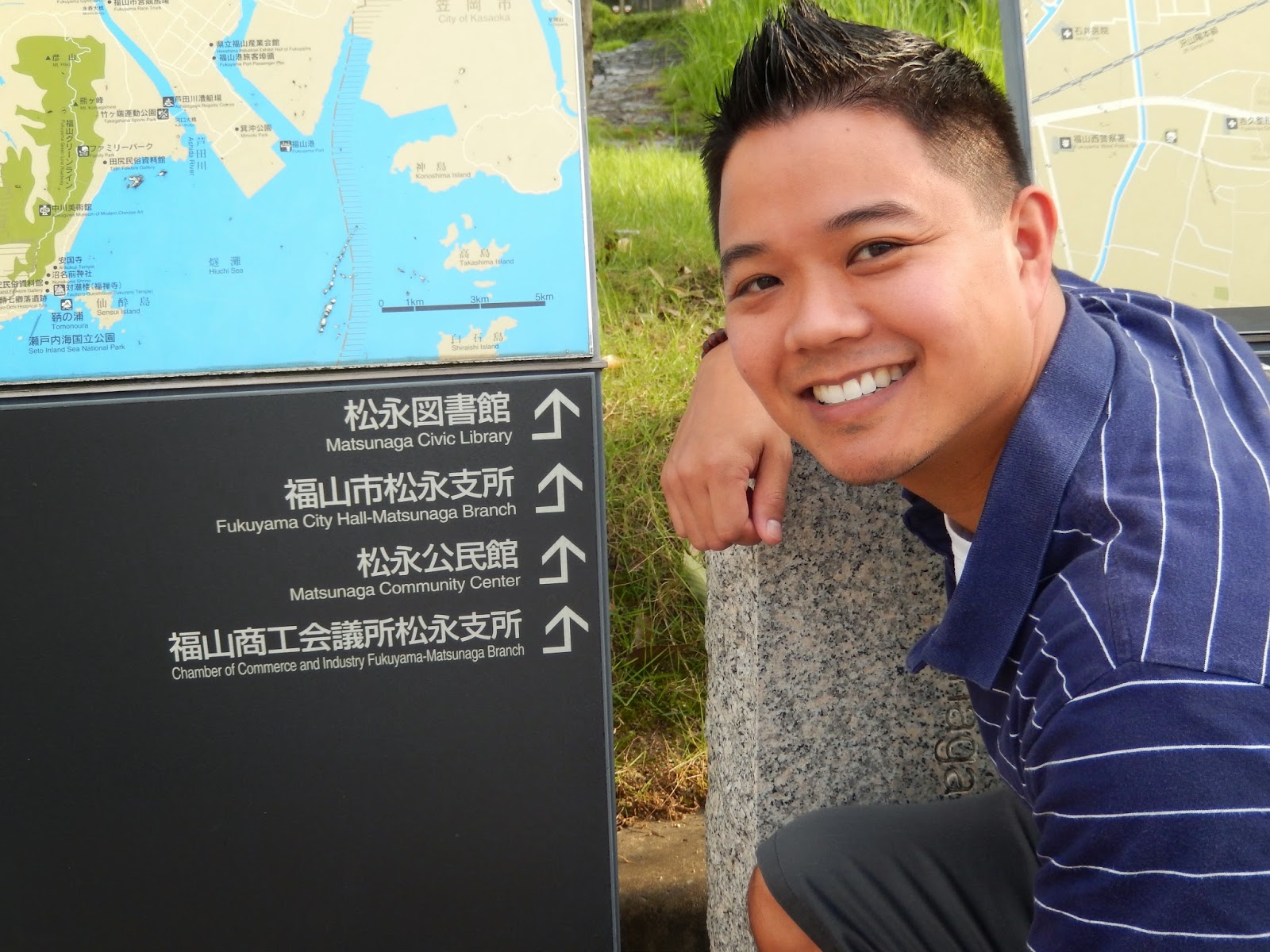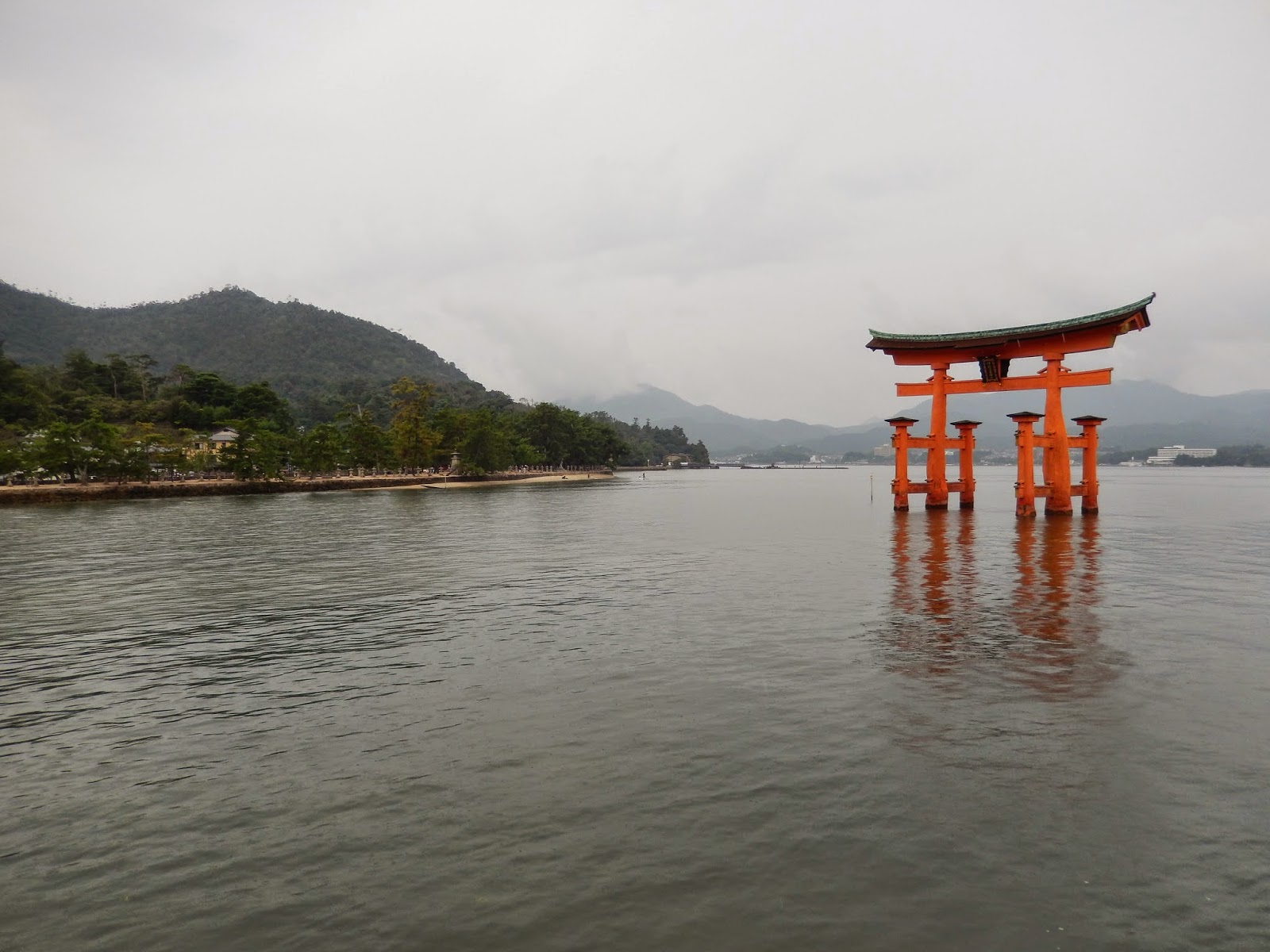In order to get to Hiroshima, we took our very first ride on a bullet train!
The speed of these bullet trains is around 150-200 mph so it only took us about four hours to get there. Even though we were traveling at such a high speed, it really didn't feel any different from the local commuter trains around town. It was a nice, smooth ride to my surprise. The inside of these trains are also very similar to that of an airplane cabin; plus they have entire passenger cars for bathrooms & smoking rooms. We were lucky because the tray table in my seat was broken so the staff moved us to a first class cabin with bigger leather seats and more leg room. SCORE!
Once we arrived in Hiroshima, we checked into our hotel and immediately headed out to board another train to Matsunaga town. As we were approaching the station, Bern could tell how excited I was to actually step foot into a town with our own namesake.
Matsunaga is more of a quiet, small-town. There wasn't any big touristy things to do in Matsunaga town. The city's only claim to fame is that it became the largest producer of geta (Japanese wooden footwear) in Japan during the Meiji era (late 1860's). In fact, there was a huge display of geta inside the Matsunaga city hall.
After exploring Matsunaga town, we actually found the same sushi go-around restaurant we normally frequent in Yokosuka so that's where we ate for our anniversary dinner.
The next day of our schedule was jammed packed because we only had one full day in Hiroshima. So we first started by visiting the Hiroshima Peace Park & Museum. A quick history lesson for those who didn't know; but Hiroshima was the first city in history to suffer from a nuclear bomb on August 6, 1945 during World War II. Three days later, U.S. military forces dropped another atomic bomb on the city of Nagasaki; the extreme devastation led Japan to surrender to the Allies. Needless to say it was quite a somber experience to be in the exact hypocenter where the atomic bomb exploded. At the foot of river stood one of the few remaining structures that managed to survive the blast. The A-Bomb Dome was the former Industrial Promotion Hall that held military offices during the war.
At the entrance of the Peace Park stands the Children's Peace Monument; it was dedicated to the children who died as a result of the bombing. Around the monument are a number of displays with many sets of 1,000 paper cranes (Japanese symbol of longevity & happiness). Further down was the Peace Flame that was first lit in 1964; it will remain lit until all the nuclear bombs in the world are destroyed. At the end of the park lies the Memorial Cenotaph; a concrete, saddle-shaped monument that holds all the names of those people killed by the bomb. If you look straight through the cenotaph, you will see the Peace Flame and the A-Bomb Dome.
The Peace Museum is the final stop at the park which covered information from the build up to the war to the actual bombing and aftermath with substantial displays/pictures throughout. Here are a couple of those displays that I thought really made an impact:
Before and After:

This next collage starting from the top left going clockwise shows 1) the atomic bomb actually exploded about 2,000 feet above the city. 2) Wax figures of people with their skin melting off due to the extreme heat & radiation of the A-bomb. 3) A clock counting the number of days since the A-bomb. 4) Display of what the actual atomic bomb looked like. 6) A globe of the world showing all the countries that have nuclear weapons (the U.S. has the most)
Leaving the museum, we felt so bad for what happened here to the people of Hiroshima. But at the same time, the Japanese forces committed serious atrocities themselves from the Pearl Harbor attack, to the Nanking Massacre in China, and even the Bataan Death March in the Philippines. So I guess the important lesson here is that War is wrong...it's ugly and should be avoided as much as possible!
Moving on, afterwards we took an hour ferry ride to the island of Miyajima, which is famous for their Torii (Shinto gate) set in the sea that was originally built in 12th century. Upon arriving, we noticed a sign at the ferry terminal warning visitors that wild deer roam freely on the island. There were many people who actually enjoyed going up to the deer and feeding them...we were not one of them!
The first item of business was to eat lunch so we went to a restaurant that had ozashiki (Japanese style seating). This was our first time eating like this and while Bern found it to be quite comfortable, I had more of a difficult time trying to adjust but still enjoyed the overall experience!
Walking through the town, we came across the world's largest rice scoop (shakushi).
Miyajima is known for their rice scoops as well as fresh oysters. There were a myriad of stands selling grilled oysters for super cheap so we had to give them a try. I actually just started eating oysters a year ago, usually raw though so eating them cooked just wasn't the same. Bern had to finish the rest of our order.
The great Torii was a sight to see! It's just too bad the weather wasn't cooperating with us, but we still managed to get some great shots of this historic Japanese landmark.
To get different vantage points of the Torii, we went to the Itsukushima Shrine that lies directly behind the Shinto gate. This particular shrine, built in 593, is dedicated to the three Shinto goddesses of the sea, fortune, & accomplishment.
We also went up the lavish mountainside of Miyajima Island to check out a five-story pagoda & the Senjokaku Pavilion. This massive, open-aired hall was built in 1587 to honor the samurai warriors who died in battle throughout Japan.
As we were walking back to the ferry, we noticed that it was now low-tide which allowed us to step down onto the sea floor and take some more pictures of the famous Torii.
Heading back to Hiroshima, a last look at Miyajima Island...
On the last day of our trip, we managed to also visit Hiroshima Castle. It was originally built in 1592, but due to the atomic bombing, it had to be re-constructed shortly after.
Do you think I can pass for a samurai? haha
After the castle, we headed back to the hotel to gather our belongings and walk to the train station. We had about an hour before the train arrived so we walked around the station and found a mini-food court that had a few restaurants serving Hiroshima's famous okonomi-yaki (Japanese style pancake with various ingredients). It was pretty good, although I had mine without the egg.
I never imagined I would one day get the opportunity to live here in Japan! The best part of this whole experience though is I get to share it with such an amazing person! Already in these past six months, we've managed to do a lot of cool things. I look forward to all the wonderful memories that still lie ahead for us here in the land of the rising sun.
I Love You Bern, Happy Anniversary!




























